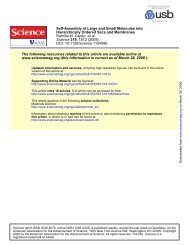Jorge Manuel de Oliveira Vicente Tese de Mestrado em Engenharia ...
Jorge Manuel de Oliveira Vicente Tese de Mestrado em Engenharia ...
Jorge Manuel de Oliveira Vicente Tese de Mestrado em Engenharia ...
You also want an ePaper? Increase the reach of your titles
YUMPU automatically turns print PDFs into web optimized ePapers that Google loves.
• Allow quality to be quantified<br />
• Reflect users’ pain points and priorities<br />
• Inclu<strong>de</strong> availability, performance, and accuracy metrics<br />
• Take into account security features and syst<strong>em</strong>s<br />
• Be realistic and affordable<br />
The best way to measure service levels is from the user’s perspective. How available were<br />
the services that users need to do their jobs and how responsive were the services? Whichever<br />
way these user perceptions are measured, the SLA will need to document each SLI used to<br />
measure the SLOs, and to specify the data source for each.<br />
For example, a Web-based application may <strong>de</strong>fine the user response time as the key SLI. It<br />
may be the case that the response time is to be measured from the time the “submit” button is<br />
pressed to the time a refreshed screen showing confirmation is received. In this case, the user<br />
perception is translated into a performance metric that must be measured by an un<strong>de</strong>rlying<br />
technology, such as a synthetic transaction, where a transaction is created to mimic user<br />
behavior for the purpose of measuring results at a given point in time [15].<br />
Availability and Performance Metrics<br />
Performance and availability metrics are essential for SLAs since they provi<strong>de</strong> necessary<br />
metrics for measur<strong>em</strong>ent.<br />
Availability is usually a simple thing to measure—was the service available when it was<br />
supposed to be or not? If it was available, but did not perform properly, then that is a<br />
performance probl<strong>em</strong>, not an availability probl<strong>em</strong>. In addition, look at the availability from the<br />
perspective of the user, not the service provi<strong>de</strong>r. In the SLA, do not inclu<strong>de</strong> separate metrics for<br />
the network, servers, and applications. Rather, represent availability by such things as total<br />
hours of availability, hours or minutes of outage, or mean time to repair.<br />
Performance is significantly more difficult to measure than availability. The trick is <strong>de</strong>ciding<br />
which aspect of performance is appropriate for the SLA that you are writing and maintaining the<br />
end-user perspective—that is, what the SLA is about. And, as with availability, keep it simple—<br />
only go as <strong>de</strong>ep as is necessary to accurately reflect the user experience.<br />
When discussing performance for an SLA, the critical question is whether the service<br />
functioned as well as it was supposed to. Usually, performance has a speed dimension to it.<br />
Speed may be represented by response time, data transfer rate, or other measures. Another<br />
common performance characteristic is volume. Volume may be reflected in the amount of data<br />
transferred, the number of transactions processed, and so forth.<br />
Unfortunately, as the size and complexity of the infrastructure for providing a service<br />
increases, so does the challenge of assessing the availability and performance of service.<br />
11

















